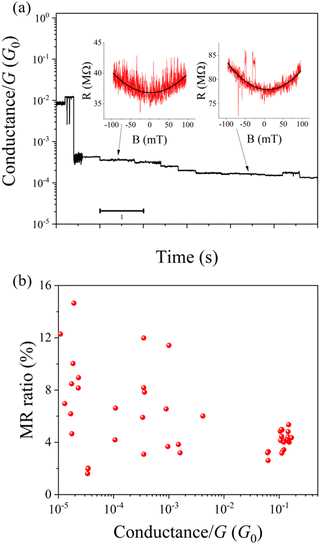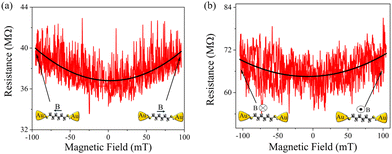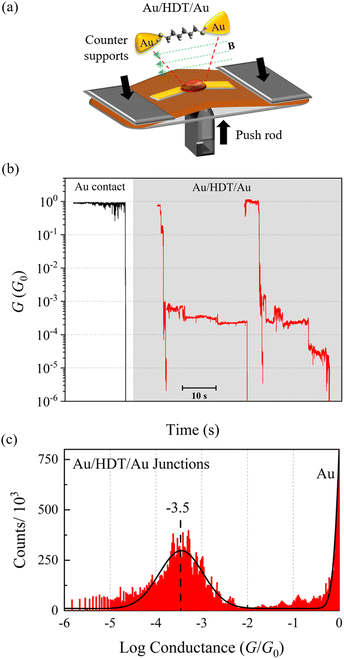 Open Access Article
Open Access ArticleMagnetoresistance originated from the Au/S interface in Au/1,6-hexanedithiol/Au single-molecule junctions at room temperature
Rachmat
Andika
 a,
Ryo
Yamada
a,
Ryo
Yamada
 ab and
Hirokazu
Tada
*ab
ab and
Hirokazu
Tada
*ab
aGraduate School of Engineering Science, Osaka University, Machikaneyama 1-3, Toyonaka, Osaka 560-8531, Japan. E-mail: tada@molectronics.jp
bCenter for Spintronics Research Network, Osaka University, Toyonaka, Osaka 560-8531, Japan
First published on 6th July 2023
Abstract
We report a magnetic response of Au/1,6-hexanedithiol/Au single-molecule junctions at room temperature using a mechanically controllable break junction method. The electrical resistance of the junction was found to increase up to 5.5% under a magnetic field. This phenomenon could originate from the unpaired charge at the Au/S interface.
The study of charge transport in single-molecule junctions has attracted considerable attention toward the development of novel electronic functions at the nano-scale.1 In single-molecule junctions, interfaces between electrodes and molecules play significant roles in electronic characteristics. Recently, the magneto-response of single-molecule junctions using ferromagnetic (FM) electrodes has been a highlight because hybridization of molecular orbitals (MOs) and electronic states in FM could form unique spin-dependent electronic structures at the interface, called “spinterfaces”2,3 that are expected to induce changes in magneto-responses, such as magnetoresistance (MR).4–6 Interestingly, the magnetic characteristics could also be formed due to the hybridization of MO and electronic states in nonferromagnetic metals.7 Sharangi et al. reported ferromagnetism at the C60/Cu interface due to the charge transfer between C60 and Cu.8 Similarly, charge transfer between S and Au has been reported to cause spin-symmetry breaking,9 which leads to a spin-polarized state and magnetism at the interface.10,11
The magnetism that emerges at the interface can open a new path for the development of magneto-responsive electronic devices without the use of FM materials. The MR of single-molecule junctions with Au/S bonds has been indicated in some studies.12,13 Various mechanisms have been proposed as follows.
Hayakawa et al.12 found that the resistance increased under a magnetic field, i.e., positive MR. They attributed the positive MR to the confinement of π-orbitals under the magnetic field, because they observed that electronic coupling is reduced under the magnetic field. Mitra et al.13 observed both positive and negative MR. They explained the MR due to the changes in scattering conditions of electrons at the Au/S interface under a magnetic field. The MR can be positive and negative depending on the structure of the Au/S interface, which cannot be precisely controlled. Large positive MR was also reported for a self-assembled monolayer of oligophenylene-thiols.14 This MR was explained by the coupling of unpaired charge localized in the molecule and the tunnelling electron. Combination of the spin between transport electrons and localized charge would create singlet (S) and triplet (T) states used as the transport channels in the junction. The energy levels of the S and T states are modulated by the magnetic field, resulting in MR.
In this work, we investigated the MR of Au/1,6-hexane-dithiol/Au single-molecule junctions (Au/HDT/Au) to clarify the role of the Au/S interface on the MR in single-molecule junctions with Au electrodes. The use of alkyl chains with a thiol anchor on gold could point out the role of Au/S interfaces in the MR effect because the localized electronic state at the Au/S interface dominates the charge transport of the alkyl-thiol and -dithiol molecular junctions.15,16 Our current investigation revealed that the parabolic positive MR of Au/HDT/Au can be produced without π-orbitals.
We employed the mechanically controllable break-junction (MCBJ) method in this study.17 The single-molecule junction was reported to be sustained for a long period, e.g., tens of seconds to hours even at room temperature using this technique.18,19 The mechanism of the MCBJ method is briefly shown in Fig. 1(a). A gold (Au) contact prepared on an elastic substrate is precisely broken by bending the substrate with the pushing rod underneath the substrate. In the presence of a molecule, molecular junctions are formed when the Au contact is broken. The molecular junctions are eventually broken by further opening the electrode gap. The electrode gap can be closed by lowering the pushing rod, and the breaking process can be repeated. The formation of molecular junctions can be detected through the transient curve of electrical conductance (G) during the breaking process. As the Au contact is elongated, G gradually decreases. When the contact becomes an atomic scale, G changes in a stepwise manner in the integer multiples of G0 where G0 = 2e2/h ∼ 7.75 × 10−5 S. It is known that a single-atomic contact of Au presents G = 1 G0. The conductance plateau at G < 1 G0 is assigned to the single-molecule junction. During the break-junction process, we could observe multiple plateaus representing single-molecule junctions with different morphologies.20
In our experiment, the house-built MCBJ machine5 was used and the single-molecule junctions can be sustained for more than 10 s, which allowed us to measure MR. The targeted molecules were adsorbed on the electrodes by putting a droplet of a 1 mM solution of them in ethanol. After the molecular solution was dried at room temperature in an Ar atmosphere, the substrate was immediately mounted onto the MCBJ setup. The MR measurements were carried out when the G value was stable for 1 s after the motion of the pushing rod. After one sweep of MR is completed, the pushing rod was raised and held for 1 s to check the stability again. This measurement sequence was repeated until the junction was broken. The magnetic field was applied at room temperature in parallel to the current flow direction. The change in the electrical resistance (R) was evaluated using the MR ratio defined as the following MR(%) = (RB − R0)/R0 × 100 where the R0 (RB) variable is the resistance without (with) the external magnetic field.
Fig. 1(b) shows G transient curves for Au electrodes without molecules (i.e., bare Au contact) and modified with HDT molecules at bias voltage, Vb = 30 mV. The formation of Au atomic contact can be observed at 1 G0. In the presence of the HDT molecules, plateaus appear below 1 G0, indicating the formation of single-molecule junctions. For HDT molecules, the plateaus are observed in the range of 10−4G0. Fig. 1(c) shows the G histograms constructed from 126 G transient curves for Au electrodes modified with HDT molecules. We found the G peak at log (G/G0) = −3.5, i.e., 3.6 × 10−4G0 for the Au/HDT/Au by fitting the Gaussian function. This is close to the values assigned for the atop-atop configuration.21,22 We should note that the single-molecule junction other than the most probable single-molecule junction configuration could be formed during the BJ experiment.23
Fig. 2(a) shows a typical G transient curve with two examples of MR responses (inset) obtained at the position indicated by the arrow for Au/HDT/Au. In this transient, we could perform 55 MR measurements, among which 7 measurements revealed the response in the magnetic field. This indicates that the MR response appears only in the specific structures of single-molecule junctions. We estimated the MR ratio by fitting the MR curves with the parabolic function as shown in the black line overlapping with the MR responses. Fig. 2(b) shows the MR ratios of all MR curves taken in the G range between 1 G0 and 10−5G0 as a function of G. All the MR curves show a positive effect. For all observed MR curves, we averaged every MR ratio of Au/HDT/Au in Fig. 2(b) to be around 5.5%.
 | ||
| Fig. 2 (a) A G transient curve of Au/HDT/Au and the MR curves with the parabolic fit (inset). (b) The plot of MR ratio as a function of G for Au/HDT/Au. | ||
Fig. 3 shows R against the external magnetic field (a) parallel and (b) perpendicular to the current flow direction for the Au/HDT/Au. The resistance increased in both curves under the magnetic field (positive MR). We should note that the different baseline of resistance value between MR curves is due to the different contact geometry of the single-molecule junction.22,23 The ratios observed for parallel and perpendicular orientations were almost 8%, respectively. This suggested no significant anisotropy in the MR behavior of Au/HDT/Au.
 | ||
| Fig. 3 The observed MR effect of the Au/HDT/Au junction in (a) parallel and (b) perpendicular magnetic field orientation with respect to the current direction. | ||
The spin scattering model proposed by Mitra et al.13 would not be appropriate because only positive MR is observed for a variety of structures in the study. Our results could be explained by modifying the mechanism related to the formation of S and T transport channels proposed by Xie et al.14 They suggested that an unpaired charge is localized in the aromatic molecule at the S side and the coupling between the localized charge and transported charge produces S and T transport channels. As the alkane-chain is used in our study, we can assume that the unpaired charge is localized not in the molecule, but in the 5d-orbital25,26 of an Au atom or in a radical S atom.24 As a result of the coupling between localized charge at the Au/S interface and transported electrons, S and T transport channels can be formed. The changes in the energy levels of the S and T transport channels under the magnetic field could produce the MR. The MR ratio observed in our study is much smaller than that reported by Xie et al., which is up to 30%. The smaller MR in our study would be due to the weak contribution of the Au/S energy state on the charge transport.
In summary, we studied a magneto transport through the single-molecule junctions of the Au/HDT/Au at room temperature by using MCBJ measurement. The junctions exhibited positive MR with average ratios of 5.5%. The MR behaviour does not show anisotropy, and it was well-fitted by the parabolic function. The MR could be associated with the unpaired charge injection at the Au/S interface.
RA: conceptualization, conducting a research and investigation process, specifically performing the experiments, or data/evidence collection, writing original draft, writing – review & editing; RY: conceptualization, formal analysis, writing – review & editing; HT: conceptualization, writing – review & editing, supervision.
This work was supported by JSPS KAKENHI Grant Number 22H00315 and 18H03899. RA thanks JICA (Japan International Cooperation Agency) for the scholarship during the research period.
Conflicts of interest
There are no conflicts to declare.References
- N. Xin, J. Guan, C. Zhou, X. Chen, C. Gu, Y. Li, M. A. Ratner, A. Nitzan, J. F. Stoddart and X. Guo, Concepts in the design and engineering of single-molecule electronic devices, Nat. Rev. Phys., 2019, 1, 211–230 CrossRef.
- S. Sanvito, Molecular spintronics: The rise of spinterface science, Nat. Phys., 2010, 6, 562–564 Search PubMed.
- I. Bergenti and V. Dediu, Spinterface: A new platform for spintronics, Nano Mater. Sci., 2019, 1, 149–155 Search PubMed.
- S. Schmaus, A. Bagrets, Y. Nahas, T. K. Yamada, A. Bork, M. Bowen, E. Beaurepaire, F. Evers and W. Wulfhekel, Giant magnetoresistance through a single molecule, Nat. Nanotechnol., 2011, 6, 185–189 CrossRef CAS PubMed.
- R. Yamada, M. Noguchi and H. Tada, Magnetoresistance of single molecular junctions measured by a mechanically controllable break junction method, Appl. Phys. Lett., 2011, 98, 053110 CrossRef.
- A. C. Aragonès, D. Aravena, J. M. Ugalde, E. Medina, R. Gutierrez, E. Ruiz, V. Mujica and I. Díez-Pérez, Magnetoresistive Single-Molecule Junctions: the Role of the Spinterface and the CISS Effect, Isr. J. Chem., 2022, 62, 1–10 CrossRef.
- F. Al Ma’Mari, T. Moorsom, G. Teobaldi, W. Deacon, T. Prokscha, H. Luetkens, S. Lee, G. E. Sterbinsky, D. A. Arena, D. A. Maclaren, M. Flokstra, M. Ali, M. C. Wheeler, G. Burnell, B. J. Hickey and O. Cespedes, Beating the Stoner criterion using molecular interfaces, Nature, 2015, 524, 69–74 CrossRef PubMed.
- P. Sharangi, P. Gargiani, M. Valvidares and S. Bedanta, Magnetism at the interface of non-magnetic Cu and C60, Phys. Chem. Chem. Phys., 2021, 23, 6490–6495 RSC.
- C. Gonzalez, Y. Simón-Manso, M. Marquez and V. Mujica, Chemisorption-induced spin symmetry breaking in gold clusters and the onset of paramagnetism in capped gold nanoparticles, J. Phys. Chem. B, 2006, 110, 687–691 CrossRef CAS PubMed.
- F. Tielens and E. Santos, AuS and SH bond formation/breaking during the formation of alkanethiol SAMs on Au(111): A theoretical study, J. Phys. Chem. C, 2010, 114, 9444–9452 CrossRef CAS.
- M. Agrachev, S. Antonello, T. Dainese, M. Ruzzi, A. Zoleo, E. Aprà, N. Govind, A. Fortunelli, L. Sementa and F. Maran, Magnetic Ordering in Gold Nanoclusters, ACS Omega, 2017, 2, 2607–2617 CrossRef CAS PubMed.
- R. Hayakawa, M. A. Karimi, J. Wolf, T. Huhn, M. S. Zöllner, C. Herrmann and E. Scheer, Large Magnetoresistance in Single-Radical Molecular Junctions, Nano Lett., 2016, 16, 4960–4967 CrossRef CAS PubMed.
- G. Mitra, J. Z. Low, S. Wei, K. R. Francisco, M. Deffner, C. Herrmann, L. M. Campos and E. Scheer, Interplay between Magnetoresistance and Kondo Resonance in Radical Single-Molecule Junctions, Nano Lett., 2022, 22, 5773–5779 CrossRef CAS PubMed.
- Z. Xie, S. Shi, F. Liu, D. L. Smith, P. P. Ruden and C. D. Frisbie, Large Magnetoresistance at Room Temperature in Organic Molecular Tunnel Junctions with Nonmagnetic Electrodes, ACS Nano, 2016, 10, 8571–8577 CrossRef CAS PubMed.
- Z. Xie, I. Baldea and C. D. Frisbie, Energy Level Alignment in Molecular Tunnel Junctions by Transport and Spectroscopy: Self-Consistency for the Case of Alkyl Thiols and Dithiols on Ag, Au, and Pt Electrodes, J. Am. Chem. Soc., 2019, 141, 18182–18192 CrossRef CAS PubMed.
- S.-Y. Guan, Z.-Y. Cai, Z.-W. Ma, D.-Y. Wu and Z.-Q. Tian, Binding structure, breaking forces and conductance of Au-Octanedithiol-Au molecular junction under stretching processes: a DFT-NEGF study, Nanotechnology, 2023, 34, 095401 CrossRef PubMed.
- B. Xu, J. Hamill and K. Wang, Characterizing molecular junctions through the mechanically controlled break-junction approach, Rep. Electrochem., 2014, 4, 1–11 Search PubMed.
- T. Konishi, M. Kiguchi, M. Takase, F. Nagasawa, H. Nabika, K. Ikeda, K. Uosaki, K. Ueno, H. Misawa and K. Murakoshi, Single molecule dynamics at a mechanically controllable break junction in solution at room temperature, J. Am. Chem. Soc., 2013, 135, 1009–1014 CrossRef CAS PubMed.
- R. Frisenda, S. Tarkuç, E. Galán, M. L. Perrin, R. Eelkema, F. C. Grozema and H. S. J. van der Zant, Electrical properties and mechanical stability of anchoring groups for single-molecule electronics, Beilstein J. Nanotechnol., 2015, 6, 1558–1567 CrossRef CAS PubMed.
- M. Gil, T. Malinowski, M. Lazykov and H. R. Klein, Estimating single molecule conductance from spontaneous evolution of a molecular contact, J. Appl. Phys., 2018, 123, 104303 CrossRef.
- X. Li, J. He, J. Hihath, B. Xu, S. M. Lindsay and N. Tao, Conductance of single alkanedithiols: Conduction mechanism and effect of molecule-electrode contacts, J. Am. Chem. Soc., 2006, 128, 2135–2141 CrossRef CAS PubMed.
- M. Taniguchi, M. Tsutsui, K. Yokota and T. Kawai, Mechanically-controllable single molecule switch based on configuration specific electrical conductivity of metal-molecule-metal junctions, Chem. Sci., 2010, 1, 247–253 RSC.
- C. Li, I. Pobelov, T. Wandlowski, A. Bagrets, A. Arnold and F. Evers, Charge transport in single Au|alkanedithiol|Au junctions: Coordination geometries and conformational degrees of freedom, J. Am. Chem. Soc., 2008, 130, 318–326 CrossRef CAS PubMed.
- S. Y. Guan, Z. Y. Cai, J. Liu, R. Pang, D. Y. Wu, J. Ulstrup and Z. Q. Tian, Adsorption, Stretching, and Breaking Processes in Single-Molecule Conductance of para-Benzenedimethanethiol in Gold Nanogaps: A DFT-NEGF Theoretical Study**, ChemElectroChem, 2021, 8, 1123–1133 CrossRef CAS.
- P. Dutta, S. Pal, M. S. Seehra, M. Anand and C. B. Roberts, Magnetism in dodecanethiol-capped gold nanoparticles: Role of size and capping agent, Appl. Phys. Lett., 2007, 90, 2005–2008 CrossRef.
- J. De La Venta, V. Bouzas, A. Pucci, M. A. Laguna-Marco, D. Haskel, S. G. E. Te Velthuis, A. Hoffmann, J. Lal, M. Bleuel, G. Ruggeri, C. De Julián Fernandez and M. A. García, X-ray magnetic circular dichroism and Small Angle Neutron Scattering studies of thiol capped gold nanoparticles, J. Nanosci. Nanotechnol., 2009, 9, 6434–6438 CrossRef CAS PubMed.
| This journal is © the Owner Societies 2023 |

